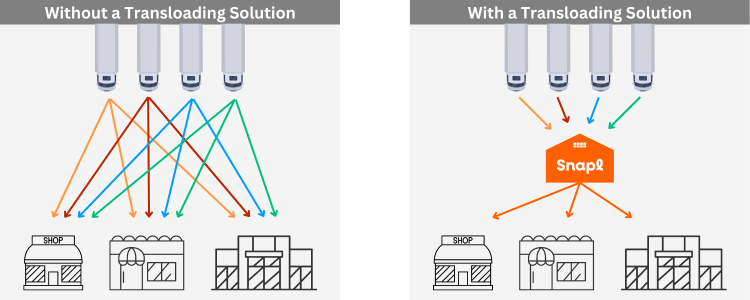
Transloading and efficient freight management are essential components of the logistics industry, offering a streamlined approach to transporting goods across diverse transportation modes while minimizing costs and optimizing delivery times. This comprehensive article dives into the intricacies of these processes, highlighting their significance in the global supply chain.
Transloading refers to the process of transferring goods from one mode of transportation to another during their journey from origin to destination. This method is particularly beneficial when direct shipments are not possible or economical due to geographical constraints or when different transportation modes offer cost or efficiency advantages at various stages of the supply chain. For instance, goods might be shipped via ocean freight from one country to another, then transferred to rail or truck for inland distribution. This flexibility allows shippers to take advantage of the strengths of each transportation mode, such as the cost-effectiveness of rail for long distances and the precision of truck deliveries for last-mile logistics.
Efficient freight management, on the other hand, encompasses the strategic planning, execution, and monitoring of freight movements to ensure timely delivery, cost-effectiveness, and minimal disruptions. It involves selecting the optimal transportation modes and routes, managing freight rates and contracts, ensuring compliance with international shipping regulations, and leveraging technology for real-time tracking and visibility. Advanced software solutions play a crucial role in efficient freight management, enabling logistics managers to optimize routing, consolidate shipments, and analyze performance data to continually improve supply chain operations.
Integrating transloading with efficient freight management strategies offers numerous benefits. It enhances supply chain flexibility, allowing companies to adapt to market changes, fluctuating demand, and unexpected disruptions by rerouting shipments or changing transportation modes as needed. This integration also supports sustainability efforts by optimizing routes and loads to reduce fuel consumption and greenhouse gas emissions. Moreover, it can lead to cost savings through more efficient use of transportation resources, reduced handling costs, and minimized storage and delay expenses.

However, managing these processes effectively requires careful coordination and expertise. Logistics providers must have a deep understanding of international trade regulations, transportation infrastructure, and the capabilities of different transportation modes. They also need to develop strong relationships with carriers, customs brokers, and other supply chain partners to ensure smooth transitions between transportation modes and compliance with all regulatory requirements.
In conclusion, transloading and efficient freight management are pivotal to enhancing the efficiency, cost-effectiveness, and resilience of global supply chains. By leveraging the strengths of various transportation modes and implementing strategic freight management practices, companies can ensure the smooth flow of goods across borders and continents, meeting the demands of an increasingly complex and dynamic global market. As the logistics industry continues to evolve with technological advancements and shifting trade patterns, the importance of these processes will only grow, underscoring the need for continuous innovation and expertise in the field.
Related Articles
How to Increase Your (AOV) Average Order Volume | February 5, 2024
What is Intralogistics? | February 4, 2024
3PL Returns Management Services and Problems They Can Help You Solve | February 1, 2024
Economic Operators Registration and Identification (EORI) Number | January 30, 2024
Understanding (DDP) Delivered Duty Paid Shipping | January 25, 2024